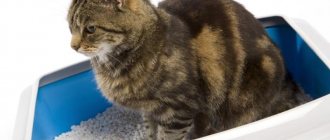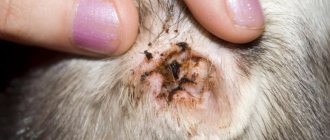First aid for a pet
What to do if your cat has bloody urine? Do not self-medicate under any circumstances, as there is a high risk that this will only harm your pet.
If you do not have the opportunity to show your animal to a veterinarian, try to consult with him by phone, he will give practical advice on how to make your pet feel better.
Still, there are a number of actions that should be performed as first aid:
- Place the cat in a clean, warm room and provide him with peace.
- To relieve pain in an animal, give it an intramuscular injection with a painkiller (no-spa, baralgin).
- Replace all of your cat's solid food with liquid foods.
- Provide the cat with the required amount of water.
- Decoctions of bearberry or parsley root have a disinfecting effect, so try giving them to your cat.
- A decoction of juniper or horsetail helps remove substances from the urinary tract that cause inflammation.
Important ! It is prohibited to give your cat antibiotics on your own without a doctor’s prescription.
First aid
If the owner notices this symptom in his pet, it is necessary to immediately contact a veterinary clinic.
If it is not possible to contact a specialist immediately, you should provide first aid yourself.
- Firstly, ensure complete rest for the animal; you should not let it go outside, or allow it to lie on a cold floor or in a windy place/room. The animal needs peace, warmth, silence and rest.
- Secondly, if the cat has severe pain, then you can inject No-shpa or Analgin with Diphenhydramine intramuscularly. The main thing is to calculate the dosage correctly, since if the dose is too large, it can lead to serious problems.
- Thirdly, in this state, the pet should eat only liquid or semi-liquid food; solid and dry food should be excluded from the diet.
Urine in cats with hematuria
Cat urine If any malfunction occurs in the body, pathological infectious and inflammatory processes develop, and the color of the urine may change.
The appearance of flakes, cloudy sediment, blood strands, and clots is possible. The condition and color of urine depends on the general physiological condition and age of the pet. As a rule, blood in the urine of pets can be seen with the naked eye. Urine acquires a brown, brown, red tint. blood clots may be oblong or round in shape. With obvious hematuria, blood is noticeable in the tray, on the animal’s fur in the area of the external genitalia.
Analysis of urine
With a mild course of the disease, in the initial stages, bloody spots in the urine are hardly noticeable. Therefore, this pathology can only be detected by laboratory diagnostic methods, microscopic tests that will show red blood cells in the urinary sediment. When examined, blood cells have their usual size and shape, or vice versa, they become deformed.
The intensity of urine color depends on the underlying cause, the concentration of red blood cells in the urine.
Diagnosis of hematuria in a veterinary clinic
When contacting a veterinary clinic, the doctor must prescribe a list of laboratory tests necessary to make an accurate diagnosis. The main diagnostic tests are:
- general urinalysis (allows you to determine the number of blood clots in urine and changes in general composition);
- bacterial culture of urine on nutrient media (makes it possible to determine the type of infectious agent for precise selection of medications);
- general and biochemical blood test (necessary to confirm inflammatory processes, and also allows you to assess the functioning of the renal structures).
Additional tests for hematuria are:
- coagulogram (determination of blood clotting factors);
- X-ray examination or ultrasound diagnostics of the abdominal organs (allows you to detect stones due to urolithiasis, as well as tumor processes and possible anomalies in the structure of the urinary system);
- cytoscopy (a study to detect pathological processes in the bladder);
- histology and biopsy (if necessary to determine the type of tumor).
During the examination, the veterinarian will first perform palpation to determine the degree of fullness of the bladder and check the animal's reaction. Additionally, ultrasound results will be required: the images will show the condition of the soft tissues. The study does not always help to detect the cause, but it confirms the presence of inflammation.
When suffering from pain, cats become aggressive and do not allow touching the problem area.
Treatment
If there are signs of dehydration, the doctor will first prescribe intravenous injections of saline solution and glucose.
In case of intoxication, vitamin K and agents intended to increase blood clotting are used.
Drug treatment is prescribed, which includes:
- Eliminating the cause of the disease by destroying pathogenic factors;
- Removing inflammatory products from the bladder;
- Suppression of pain and spasms;
- Restoration of diuresis and acid-base balance. Antibiotics are used to treat hematuria, combining them with pathogenic and symptomatic therapy.
With the development of KSD, the nature of the salts is determined in order to dissolve them. In severe cases, surgical removal of stones or their crushing using a laser is used.
Causes of blood in urine
Blood in the urine of felines can occur for a variety of reasons. This pathology can be provoked by various exo- and endogenous factors. The etiology of hematuria in most cases involves disturbances in the functioning of the genitourinary tract of animals, various urological pathologies and diseases.
Bloody staining of urine is most often diagnosed with urolithiasis, cystitis, pyelonephritis, and urethritis. In some cases, this pathology may be the result of impacts, severe injuries, or falls from a height.
Causes of blood in the urine of cats:
- hemorrhages in the kidneys;
- the presence of endoparasites (helminths) in the renal pelvis and bladder;
- chronic cystitis, urethritis, glomerulonephritis;
- infectious, viral, bacterial diseases;
- chemical, feed poisoning;
- acute inflammation in the organs of the urinary system;
- diseases of the lower urinary system;
- the presence of tumors in the kidneys (lymphosarcoma), urinary tract cancer;
- congenital anatomical anomalies of the pelvic organs.
Blood staining of urine can also be caused by long-term use of certain medications - corticosteroids, anti-inflammatory drugs, painkillers.
Cat on the toilet
Hematuria often develops against the background of various infections, systemic pathologies, as well as after injuries to the genital organs, bladder, for example, after animals fall from a great height. Blood in the urine of cats may indicate that the animal is being fed low-quality prepared food.
The causes of hematuria include: heart attack, polycystic kidney disease, vascular abnormalities in the organs of the genitourinary tract, changes in the shape of the bladder in the case of the formation of polyps, diverticula, and calculi.
Bloody inclusions and blood cells in the urine may appear after surgical operations on the peritoneum, sterilization, or catheterization. In castrated cats and older animals, the presence of blood in the urine always indicates the development of urolithiasis. In cats, bloody spots in the urine may be noticed in the first two to four days after birth or during estrus.
Main symptoms of cat disease
Chlamydia, rickettsia, mycoplasma, and various types of helminths can also provoke the development of hematuria.
Severe bleeding is caused by toxic substances, hemolytic poisons, tumors, and acute inflammation of the bladder. In case of diseases of the reproductive system, urine may be contaminated with bloody discharge from the vagina and prepuce.
It is possible to establish the exact cause that led to the development of hematuria in cats only after undergoing comprehensive diagnostics and laboratory tests at a veterinary clinic.
Manifestations of hematuria
Cats' urine is normally clear with a pale yellowish-orange tint. In the first stages of the pathology, the symptom is mild. Urine is slightly shaded. The color changes depending on the level of red blood cells. The redder the urine, the more blood cells it contains.
© shutterstock
Sometimes even small blood clots are visible in the urine. This happens very rarely. Such symptoms indicate an advanced stage of the disease. To control, it is best to choose a light filler for the tray and each time look to see if the color of the urine changes (or intensifies) in the red direction. Sometimes it is impossible to notice changes visually, only with the help of laboratory tests.
Surgical methods
Surgery occurs when the urethra is completely blocked. It is important to carry out the intervention as soon as possible, since delay can result in death. This disorder most often occurs in cats.
If stones are found in the bladder, surgery is also necessary. Despite the absence of a direct threat to the life of the animal, a pebble can close the duct and this will result in serious problems.
Surgery is required when a tumor and polyps are detected. Neoplasms tend to degenerate into malignant ones, and this can already lead to death.
Treatment
Symptoms of hematuria
The cat looks sick. The main symptom of hematuria in cats is a sudden change in the color of the urine. Bloody inclusions, clots, and strands are noticeable in the urine. This pathology is accompanied by other symptoms, including:
- frequent urge to urinate;
- painful urination;
- deterioration of general physiological condition;
- loss of appetite, refusal of favorite treats;
- decreased physical activity, drowsiness, apathy.
The cat often meows and shows anxiety when trying to go to the litter box. If hematuria occurs against the background of bacterial and viral infections, an increase in general temperature is possible in the initial stages of the disease.
Cat with apathy
Experiencing discomfort and pain, animals can rush around the apartment and try to do “their business” in the wrong place. Cats hide in dark corners, secluded places, and lie on their stomachs on cold tiles. Reaction to external stimuli decreases. Just yesterday, an active and cheerful pet refuses to participate in outdoor games and shows little interest in the world around him.
Having noticed the first alarming symptoms, you should not delay your visit to the veterinarian and self-medicate. Timely, correct prescribed treatment can only be prescribed by a veterinarian after diagnosis.
Diagnostics
Diagnosing hematuria To eliminate the symptoms of hematuria in cats, it is necessary to find the root cause that caused this pathology.
Veterinary specialists, in addition to collecting medical history and a comprehensive examination of four-fingered patients, must conduct a number of laboratory tests of urine. Before submitting urine for analysis, you need to remove the litter and thoroughly disinfect the cat litter box. After the pet goes “little by little,” collect it from the tray with a disposable syringe into a special sterile container, which can be purchased at a pharmacy, veterinary pharmacy, or veterinary clinic.
Urine collection is carried out three to four hours before submitting the material for analysis, and only in the morning. It is advisable to keep your pet on a fasting diet for 12 hours. If your pet is being treated, tell your veterinarian what medications are prescribed for your pet.
In case of difficulty urinating, urine for analysis is taken during catheterization in a veterinary hospital.
The delivered sample is tested in laboratories using various test systems that make it possible to determine the concentration of red blood cells, the presence of leukocytes, pathogenic microorganisms, acetone, pus, and epithelium in the urine. Based on the test results, the physicochemical properties of urine will be determined.
For additional diagnostics and clarification of the diagnosis, radiography of the bladder and ultrasound of the genitourinary system are prescribed.
Signs of hematuria
Vomiting blood in a cat: reasons, what to do
At the initial stages of development of a pathological condition, it is not easy to identify it. Urine is only slightly reddish in color, but the owners do not notice this because the urine is absorbed by the tray filler or they simply do not pay attention.
Cat owners begin to sound the alarm when there is pronounced blood during trips to the toilet. In this case, urine is colored in the following colors:
- pink;
- scarlet;
- red;
- brown.
To identify the problem at the initial stages, it is recommended to teach your pet to pee in an empty tray or choose a light-colored litter. The cat itself can tell the owner that it is not feeling well: it will go to the toilet past the potty, lie down next to it and meow.
In order not to waste precious time, you need to constantly monitor the behavior of your pet. Malaise is indicated by lethargy and apathy or, on the contrary, increased agitation and aggressiveness even in a well-fed state.
Collecting urine for analysis
If the owner notices bloody urine in a cat, the first thing he should do is take a urine test to diagnose the disease.
A simple option for collecting material for analysis:
- The tray is cleared of filler.
- Cleans well with boiled water (do not use chemicals!).
- Then you just have to wait for the pet to go to the toilet.
However, most pets will only go to the litter box if there is litter in it. In this case, it will not be possible to collect the liquid. Therefore, owners will have to resort to small tricks.
- You can try to watch the animal and, as soon as it settles into the tray, place a clean saucer or small bowl under it. The collected liquid is poured into a clean container and taken to the laboratory.
- You can buy a special kit at a pet store : it consists of granules for the potty and a container for urine. This filler does not have an absorbent effect.
- You can use small aquarium pebbles as soil for the tray , preferably unpainted. You can find glass cabochons on sale that are also suitable. After the cat has done its business, the urine is collected with a sterile syringe, poured into a container and taken to the laboratory.
In severe cases, with complete obstruction of the urethra, the cat should be immediately taken to the veterinarian. He will insert a catheter, drain any accumulated urine, and collect it for analysis.
The material must be delivered for research immediately, as it quickly loses its freshness. This must be done within 4 hours.
Urine with blood
Treatment of hematuria in cats
The treatment regimen and course of treatment are prescribed by a veterinary specialist based on the results of diagnostic studies. Treatment methods are aimed at eliminating the root cause, normalizing the general condition of animals, and relieving the main symptoms of the disease. The sooner treatment is prescribed, the faster the condition of your beloved pet will normalize. The risk of developing chronic pathologies and serious complications is reduced.
Furry patients are prescribed anti-inflammatory, antispasmodic, and analgesic pharmacological agents. To relieve pain symptoms, painkillers are administered intramuscularly. If hematuria has developed against the background of infectious diseases, broad-spectrum antibiotics, cephalosporin and penicillin antibacterial drugs can be prescribed for treatment.
For genital infections, the external genitalia are washed with decoctions and tinctures based on medicinal plants.
In addition, cats can be prescribed a therapeutic diet and their diet adjusted. Cats are provided with peace and optimal living conditions. Ready-made dry food is excluded from the diet, with the exception of medicinal foods, and solid food. You can feed a sick animal only easily digestible foods, having previously agreed on the feeding regimen and nutrition with the treating veterinarian. Animals should always have access to fresh drinking water.
Treatment of hematuria
Additionally, homeopathic remedies, immunomodulators, and vitamin and mineral complexes are prescribed to increase the body's resistance. During antibiotic therapy, enzyme agents are prescribed to normalize the intestinal microflora.
What to do if your cat is peeing blood
If the owner has discovered unusual discharge in the pet's litter box, then one should not self-medicate. If you can’t immediately take your cat for an examination, you can get advice by phone. If necessary, the doctor will prescribe painkillers to slightly alleviate the patient’s condition. The main recommendations will be:
- ensuring peace for the pet;
- placement in a dry and warm room;
- feeding liquid food;
- ensuring access to clean water;
- the use of decoctions of juniper, parsley or horsetail to reduce inflammation.
Such measures will maintain the relatively normal condition of the mustachioed friend, but will not cancel visits to the doctor. Before this, it would be a good idea to collect tests on the animal so that the clinic can conduct research and quickly prescribe medications.
Treatment Options
If a cat often pees with blood, then the treatment of this condition will depend directly on the provoking factor. So, if they suffer from urolithiasis, then catheterization of the bladder is prescribed. It ensures the normal outflow of urine through the urethra, while infusion therapy and anti-inflammatory drugs are additionally prescribed.
Other options for eliminating hematuria:
- If blood in the urine is caused by malignant or benign formations , then surgical intervention is prescribed. After tumor removal, it is recommended to follow a number of recommendations from a specialist to prevent re-bleeding;
- Hematuria caused by parasitic diseases is eliminated after an effective course of deworming. Additionally, vitamin and mineral complexes are prescribed to strengthen the pet’s condition;
- When a cat pees with blood after castration (sterilization ), then, depending on the cause, a tight bandage, special massage, drug therapy, and surgical treatment are prescribed.
The treatment program is selected individually. The veterinarian takes into account the cause of hematuria, as well as the general condition of the pet and the characteristics of its body. Timely contact with a specialist is the key to successful treatment for your cat!
What to do if blood appears in the urine: treatment at home
In severe situations, when bleeding threatens life, or calculi (stones) clog the lumen of the excretory canals and block the outflow of urine, surgery is performed in the clinic. In most cases, the animal owner takes part in treating the pet at home, following the orders of the veterinarian.
The therapeutic strategy is based on diet therapy and drug treatment.
Diet therapy
If a cat pees in blood, then proper nutrition cannot be avoided for the following reasons:
- It is necessary to maintain average fatness. Cats that do not walk outside, especially sterilized ones, are prone to overeating with reduced physical activity. Boredom causes them to develop an appetite. In obese pets, metabolism slows down, fat puts pressure on the urinary organs, urine stagnates, which contributes to the attachment of microbes to the wall of the bladder, as well as the precipitation of urinary salts.
- Economy class feeds and natural products are unbalanced in protein. They have a low concentration of energy, little dietary fiber and vitamins. A significant part of the defective protein is not digested and is converted into uric acid. Nitrogenous slag is poorly soluble in water, is prone to precipitation and is a breeding ground for microbes.
- In animals predisposed to urolithiasis, 2 types of stones form. Phosphorus-rich struvite forms in alkaline urine. In acidic urine, oxalates—calcium salts and oxalic acid—precipitate. The veterinarian conducts a urine test, makes a diagnosis, based on which he recommends the use of specialized medicinal food.
Depending on the presence of stones and the patient’s condition, the following veterinary feeds are used:
- Purina UR for urolithiasis;
- Hill's Metabolic + Urinary for weight loss and struvite dissolution;
- Eukanuba Urinari Oxalate;
- Eukanuba Urinari Struvite;
- Royal Canin Neutered Adult Maintenance for the prevention of urolithiasis and obesity in sterilized cats.
Be sure to read:
A cat is vomiting hair: reasons, what to do, medications and folk remedies, prevention
Medicines and folk remedies
Veterinarians prescribe complex remedies. The drug Stop-cystitis in tablets or suspension contains the antibiotic nitroxoline and the antispasmodic drotaverine, which inhibit pathogenic microflora, relieve spasms and relieve pain.
Most of the drugs popular in the treatment of diseases of the urinary canal, kidneys and bladder are produced on the basis of traditional medicine and are a mixture of extracts of medicinal herbs.
The following herbal remedies are popular:
- Stop Cystitis Bio;
- Erwin the cat;
- Phytodoc Nefrospas;
- Urolex;
- Urinari tract support.
Prevention
To prevent the appearance of blood in the urine and the development of other diseases, owners must provide optimal care and living conditions for their furry pets. It is equally important to carry out timely preventive deworming and treatment of animal fur from ectoparasites (fleas, ticks).
Tired cat
It is very important to monitor the behavior and general condition of your pet. Pay attention to hygiene, the cat’s immunity, and organize a proper diet. In order not to provoke the development of urolithiasis, the diet should not contain low-quality industrial feed with a high content of salts, flavors, and stabilizers.
If your pet's condition worsens, do not self-medicate. Contact your veterinarian or take your animal to a veterinary clinic.
We invite you to join our Zen channel and group on VKontakte or Odnoklassniki, where new articles for pet owners are published.
Similar articles:
- My cat has a nosebleed - what should I do?
- Inflammation of the lower lip in a cat
- Clear nasal discharge in cats
Prevention of hematuria
Hematuria is a common problem among cats. It is a symptom of many diseases and often occurs due to injuries (damage). To prevent the appearance of blood in the urine of a neutered cat, provide him complete rest in the first 24 hours after surgery, do not allow him to scratch the wound and make sure that he does not climb even to a small height (sofa, bed, table, etc.).
Other preventative measures include:
- Proper nutrition. This is especially true for castrated and sterilized cats, as well as animals with a predisposition to developing urolithiasis. Consult your veterinarian on how to choose the right medicinal food;
- Vitamin support . A weak immune system is one of the factors that provokes the occurrence of diseases, a sign of which is bleeding. In addition, vitamin A deficiency contributes to the development of urolithiasis;
- Drink plenty of fluids . To prevent salt, sand and other solid particles from gradually accumulating in the genitourinary system, it is important to provide your pet with free access to fresh and clean water. Make sure there is always plenty of it.
Identifying the causes and treating blood in a cat's urine is the responsibility of veterinarians. A timely visit to a specialist will allow you to avoid unwanted consequences and restore the health of your beloved pet!
What is cystitis and its features
Cystitis is an inflammation of the inner lining of the bladder. There is partial inflammation and complete inflammation of the membrane. If the inner lining is completely engulfed by inflammation, there will be blood in the cat’s urine due to damage to the walls of the blood vessels.
Cystitis is divided into acute and chronic:
— Acute occurs suddenly, progresses in a matter of hours, all signs are obvious.
— Chronic is characterized by vague symptoms.











